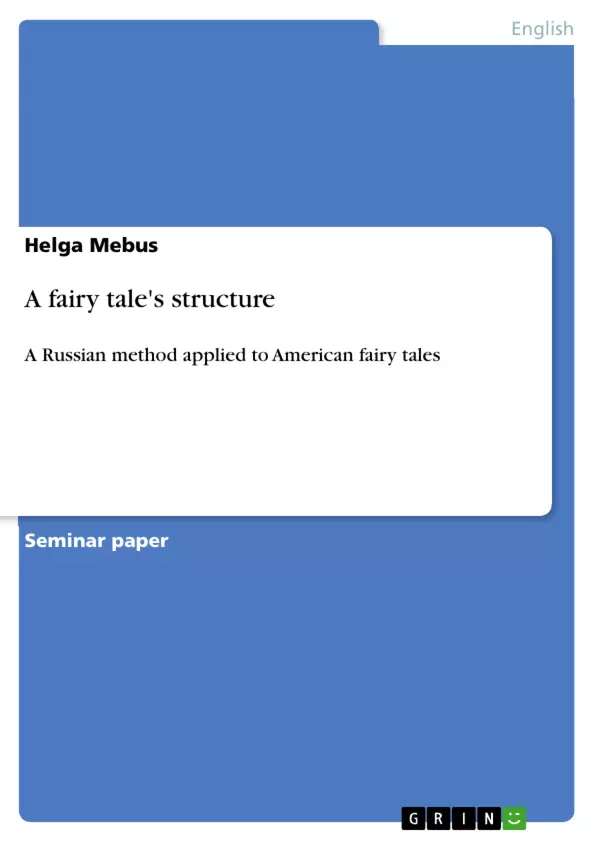Fairy tales are an interesting genre to me, so I decided to look upon them in greater detail. To analyze a fairy tale’s meaning seems to be a task almost impossible to fulfill, though. “Every reader reads a different story. Writers who confidently tell us what fairy tales ‘mean’ are oversimplifying their complex, multilayered character,” states The Cambridge Guide to Children’s Books in English (Watson 2001: 249) concerning the matter. Further on, it says that fairy tales “do not contain meaning and they cannot impart meaning. They allow meanings to be made” (Watson 2001: 249). I began to wonder how fairy tales can be compared if not by their meaning and what they might have in common. The question leads to another approach on fairy tale analysis: a structural one.
Vladimir Propp’s Morphology of the Folktale gives a scheme for the structure of fairy tales; it will be described in the following chapter. His work was originally written for Russian fairy tales but could supposedly be applied to other ones, too (Propp 1968). Therefore, I decided to try it on a small collection of American fairy tales by L. Frank Baum to find out their structure. The collection is named American Fairy Tales and contains twelve short tales of various types. My interest lay in finding out if Propp’s scheme can be applied to the considered American fairy tales by Baum. This would indicate that they have a similar structure as the tales Propp classifies as fairy tales.
In the following, Propp’s method will be described and is then applied to the tale “The Queen of Quok” out of Baum’s collection (1978: 43-61) in all detail. Further on, examples of the other tales by Baum and the results of their analyses according to Propp’s scheme will be shown. Conclusions are drawn afterwards.
Table of Contents
- Introduction
- The theory by Vladimir Propp
- Morphology of "The Queen of Quok"
- Other Tales out of Baum's Collection
- Conclusion
Objectives and Key Themes
The objective of this paper is to apply Vladimir Propp's structural analysis of fairy tales to a collection of American fairy tales by L. Frank Baum. The paper examines whether Propp's scheme, originally developed for Russian fairy tales, can be applied to American fairy tales, thus highlighting their structural similarities.
- The structural analysis of fairy tales
- Vladimir Propp's theory of fairy tale structure
- Application of Propp's theory to American fairy tales
- The analysis of "The Queen of Quok" and other tales from Baum's collection
- The structural similarities between Russian and American fairy tales
Chapter Summaries
- Introduction: This chapter introduces the topic of analyzing fairy tales and explores the challenges of defining their meaning. It presents the idea of a structural approach to fairy tale analysis and introduces Vladimir Propp's work as a potential framework for this analysis.
- The theory by Vladimir Propp: This chapter provides a detailed overview of Propp's theory of fairy tale structure. It outlines the key components of his scheme, including the concept of functions, spheres of action, and the significance of the hero's intentions. It also discusses the four types of fairy tales according to Propp's classification.
- Morphology of "The Queen of Quok": This chapter applies Propp's scheme to the fairy tale "The Queen of Quok" from Baum's collection, analyzing the tale's structure in detail and identifying the functions and spheres of action present.
- Other Tales out of Baum's Collection: This chapter examines other tales from Baum's collection, applying Propp's scheme to identify their structural similarities and differences.
Keywords
This paper focuses on the structural analysis of fairy tales using Vladimir Propp's theory. It examines the application of Propp's scheme to American fairy tales, focusing on the collection by L. Frank Baum. Key terms include fairy tale structure, function, sphere of action, morphology, and comparative analysis.
- Quote paper
- Helga Mebus (Author), 2005, A fairy tale's structure, Munich, GRIN Verlag, https://www.grin.com/document/93216




